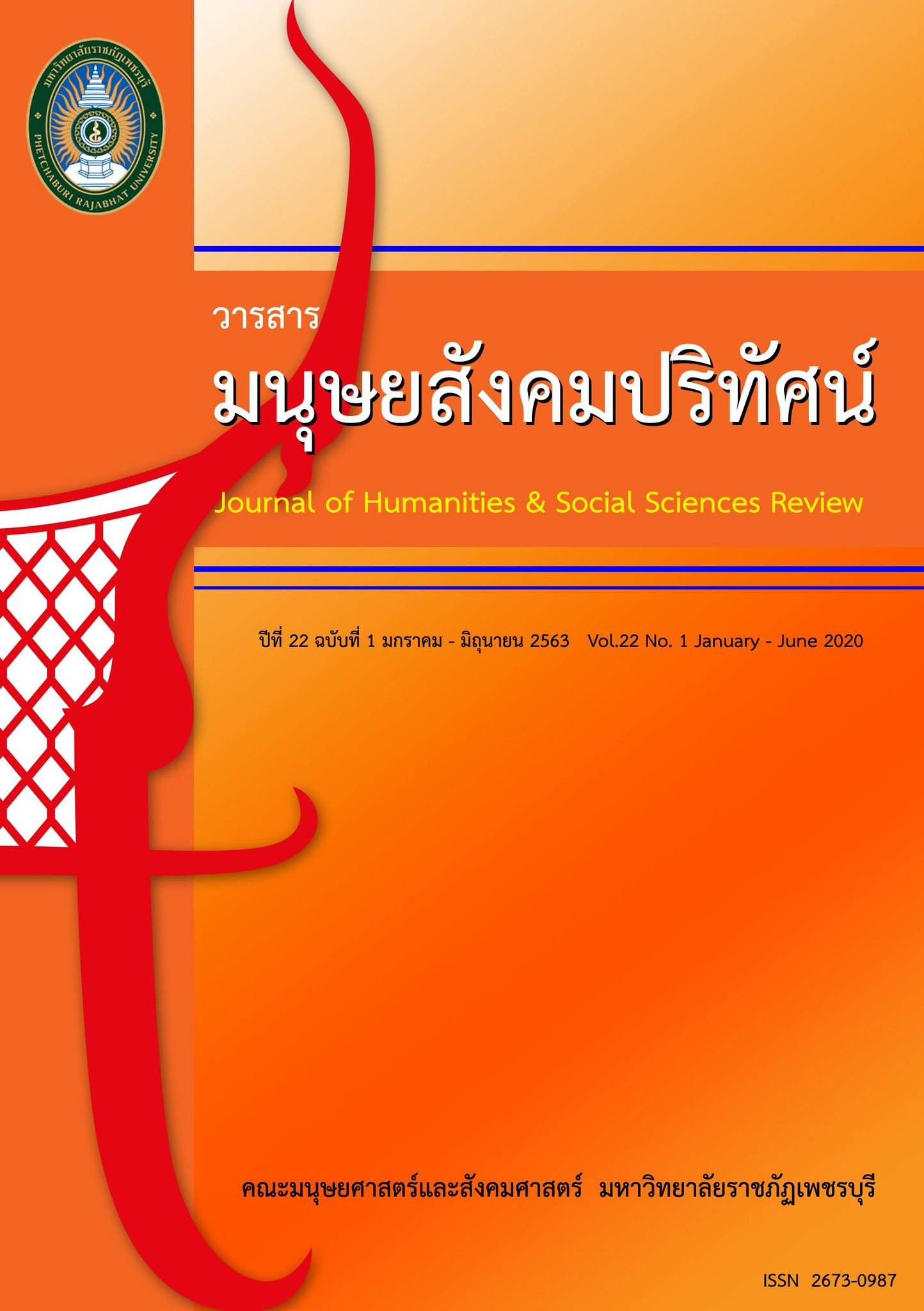การพัฒนาบทเรียนออนไลน์เพื่อพัฒนาความสามารถใน การเขียนแผนการจัดการเรียนรู้สังคมศึกษาของนักศึกษา สาขาวิชาสังคมศึกษาชั้นปีที่ 4 คณะมนุษยศาสตร์และสังคมศาสตร์ มหาวิทยาลัยราชภัฏเพชรบุรี
Main Article Content
บทคัดย่อ
การวิจัยครั้งนี้มีวัตถุประสงค์เพื่อ 1) เพื่อสร้างบทเรียนออนไลน์เพื่อพัฒนาความสามารถในการเขียนแผนการจัดการเรียนรู้สังคมศึกษา และ 2) เพื่อเปรียบเทียบความสามารถในการเขียนแผนการจัดการเรียนรู้สังคมศึกษาก่อนและหลังใช้บทเรียนออนไลน์ ประชากรที่ใช้ในการวิจัย คือ นักศึกษาสาขาวิชาสังคมศึกษาชั้นปีที่ 4 คณะมนุษยศาสตร์และสังคมศาสตร์ มหาวิทยาลัยราชภัฏเพชรบุรี ที่กำลังศึกษาอยู่ในภาคเรียนที่ 1 ปีการศึกษา 2561 จำนวน 35 คน เครื่องมือที่ใช้ในการวิจัย ได้แก่ มคอ.3 รายวิชาการจัดการเรียนรู้สังคมศึกษา บทเรียนออนไลน์ เรื่อง การเขียนแผนการจัดการเรียนรู้สังคมศึกษา และแบบประเมินความสามารถในการเขียนแผนการจัดการเรียนรู้ วิเคราะห์ข้อมูลโดยใช้ค่าเฉลี่ย ส่วนเบี่ยงเบนมาตรฐาน และการทดสอบค่าที (t-test) ผลการวิจัยพบว่า บทเรียนออนไลน์มีประสิทธิภาพ 81.20/84.33 ซึ่งสูงกว่าเกณฑ์ ที่กำหนดไว้ 80/80 และผลการประเมินความสามารถในการเขียนแผนการจัดการเรียนรู้สังคมศึกษาของนักศึกษาสาขาวิชาสังคมศึกษา หลังใช้บทเรียนออนไลน์สูงกว่าก่อนใช้ อย่างมีนัยสำคัญทางสถิติที่ระดับ 0.05
Article Details
1. มุมมองและความคิดเห็นใด ๆ ในบทความเป็นมุมมองของผู้เขียน คณะบรรณาธิการไม่จำเป็นต้องเห็นด้วยกับมุมมองเหล่านั้นและไม่ถือเป็นความรับผิดชอบของคณะบรรณาธิการ ในกรณีที่มีการฟ้องร้องเกี่ยวกับการละเมิดลิขสิทธิ์ ให้ถือเป็นความรับผิดชอบของผู้เขียน แต่เพียงผู้เดียว
2. ลิขสิทธิ์บทความที่เป็นของคณะมนุษยศาสตร์และสังคมศาสตร์ มหาวิทยาลัยราชภัฏเพชรบุรีมีลิขสิทธิ์ถูกต้องตามกฎหมาย การเผยแพร่จะต้องได้รับอนุญาตโดยตรงจากผู้เขียนและมหาวิทยาลัยราชภัฏเพชรบุรีเป็นลายลักษณ์อักษร
เอกสารอ้างอิง
กระทรวงศึกษาธิการ. (2553). หลักสูตรแกนกลางการศึกษาขั้นพื้นฐาน พุทธศักราช 2551 (พิมพ์ครั้งที่ 2). กรุงเทพฯ: โรงพิมพ์ชุมนุมสหกรณ์การเกษตรแห่งประเทศไทย.
กระทรวงศึกษาธิการ, กรมวิชาการ. (2545). คู่มือการจัดการเรียนรู้กลุ่มสาระการเรียนรู้การงานอาชีพและเทคโนโลยี. กรุงเทพฯ: โรงพิมพ์องค์การรับส่งสินค้าและพัสดุภัณฑ์.
กิดานันท์ มลิทอง. (2548). เทคโนโลยีและการสื่อสารเพื่อการศึกษา. กรุงเทพฯ: อรุณการพิมพ์.
เขมณัฏฐ์ มิ่งศิริธรรม. (2559). การออกแบบสื่อการศึกษาสร้างสรรค์ (CREATIVE EDU CATIONAL MEDIA DESIGN). กรุงเทพฯ: สำนักพิมพ์จุฬาลงกรณ์มหาวิทยาลัย.
ใจทิพย์ ณ สงขลา. (2550). วิธีวิทยาการออกแบบการเรียนการสอนอิเล็กทรอนิกส์ = E-instructional design. กรุงเทพฯ: ศูนย์ตำราและเอกสารทางวิชาการ จุฬาลงกรณ์มหาวิทยาลัย.
ชัยยงค์ พรหมวงศ์. (2525). เอกสารการสอนชุดวิทยาการสอน. กรุงเทพฯ: ชวนพิมพ์.
ไพฑูรย์ สินลารัตน์. (2524). หลักและวิธีการสอนระดับอุดมศึกษา. กรุงเทพฯ: ไทยวัฒนาพานิช.
ภพ เลาหไพบูลย์. (2542). แนวการสอนวิทยาศาสตร์. กรุงเทพฯ: ไทยวัฒนาพานิช.
มนต์ชัย เทียนทอง. คณะเทคโนโลยีสารสนเทศ สจพ. สืบค้นเมื่อ 28 พฤศจิกายน 2562, จาก
http://suanpalm3.kmutnb.ac.th/teacher/FileDL/monchai135255218573.pdf
ศุภลักษณ์ ทองจีน. (2558). การออกแบบและการจัดการเรียนรู้. อุดรธานี: ศูนย์การศึกษา บึงกาฬ มหาวิทยาลัยราชภัฏอุดรธานี.
สุวิทย์ มูลคำ และคณะ. (2549). การเขียนแผนการจัดการเรียนรู้ที่เน้นการคิด. กรุงเทพฯ: ภาพพิมพ์.
อุดมลักษณ์ อนันต์. (2549). การพัฒนาบทเรียนออนไลน์เอ็ดดูเทนเมนต์โดยใช้แอนิเมชั่นเรื่องการวัด (2552). คู่มือประกอบการอบรม Moodle ระดับผู้จัดการระบบ. กรุงเทพฯ. และประเมินผลการศึกษา. วิทยานิพนธ์ ปริญญาครุศาสตรมหาบัณฑิต, สาขาวิชาครุศาสตร์ เทคโนโลยีมหาวิทยาลัยเทคโนโลยี พระจอมเกล้าธนบุรี.
ฤทธิชัย อ่อนมิ่ง. (2547). การออกแบบและพัฒนาบทเรียนคอมพิวเตอร์มัลติมีเดีย. กรุงเทพฯ: ภาควิชาเทคโนโลยีการศึกษา คณะศึกษาศาสตร์ มหาวิทยาลัยศรีนครินทรวิโรฒ.
Parson, R. (1997). An Investigation into Instruction Available on the World Wide Web. (On-line) Available http://www.osie.on.ca/~rparson/outId.html [September 18].


